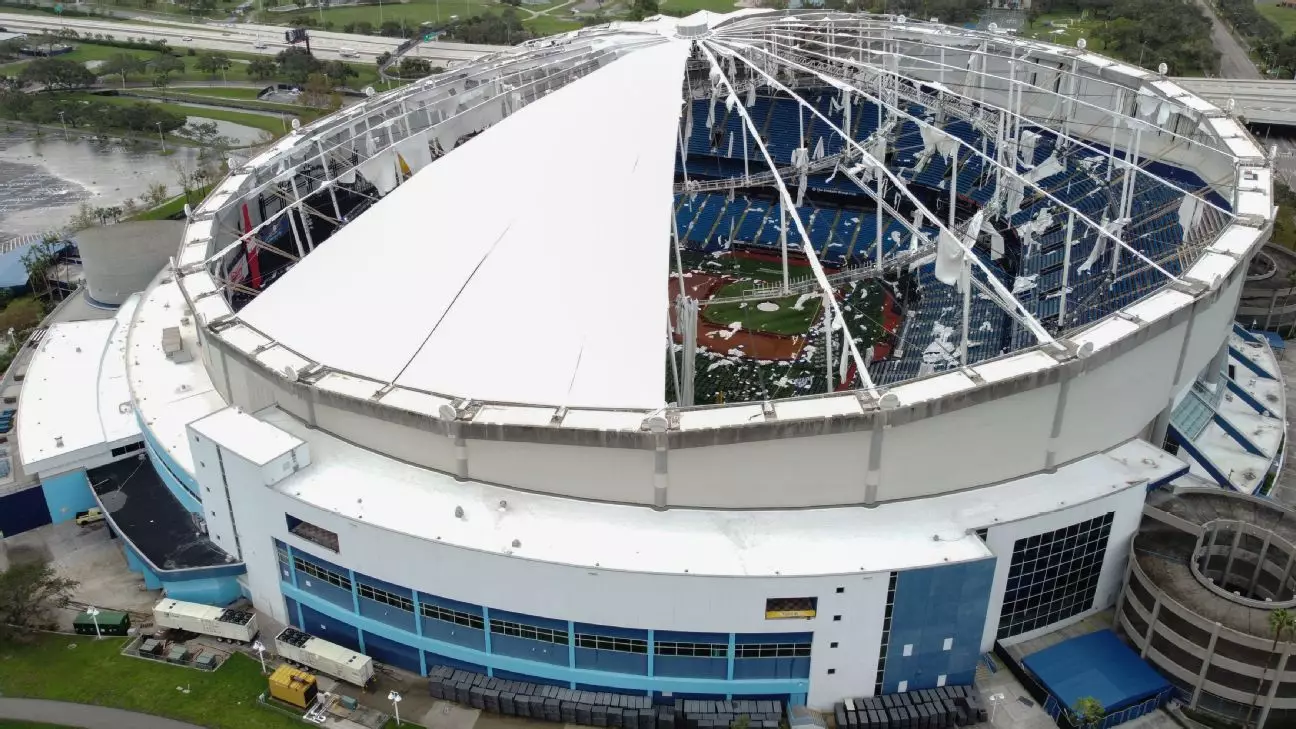The St. Petersburg City Council’s recent decision to allocate $22.5 million for repairs to Tropicana Field represents a significant turning point for the Tampa Bay Rays and baseball in the region. Following Hurricane Milton’s destructive whirlwind, which left the stadium’s roof in tatters, this financial commitment emphasizes both a legal obligation and a community steadfastness to maintain major league sports in the area. For fans and stakeholders alike, the verdict underscores a broader conversation about infrastructure development and the future home of the Rays.
Amid the chaos of a natural disaster, the council’s resounding 7-1 vote emerges as a beacon of hope for both the franchise and its fanbase. Council Member Lissett Hanewicz, a prominent legal voice in the discussions, voiced a sentiment felt by many: “We are legally bound by an agreement.” This highlights the intricate web of contracts often entwined with public expenditure, leaving the city faced with not only the logistics of the repairs but also the expectations of a loyal fanbase yearning for baseball’s return.
The Temporary Home Advantage
The ongoing repairs mean that the Rays have had to take their talents across the bay, to Steinbrenner Field, the spring training home of the New York Yankees. While a getaway to an open-air ballpark has been novel—evidenced by a promising 4-2 record—this situation is merely a stopgap measure. The unique atmosphere of a passionate local crowd, synonymous with the Trop, is irreplaceable.
Additional challenges present themselves as the Rays may be left reevaluating their long-term future. The current agreement ties them to Tropicana Field through 2028, but questions loom about whether they’ll choose to renew their commitment to St. Petersburg or eye a more lucrative stadium deal in Tampa or elsewhere. Major League Baseball has flagged maintaining a franchise presence in the region as a priority, which serves as reassurance for a region whose sporting aspirations hinge on New Era cap-wearing youth and veteran fans alike.
A Complex Path Forward
With a total estimated repair cost of $56 million, the dynamic landscape of the project encompasses more than just a new roof. City architect Raul Quintana emphasizes that while the membrane roofing system—set to endure winds up to 165 mph—forms the project’s initial focus, subsequent repairs will encompass vital elements like the playing surface, audio-visual capabilities, concessions, and even renovations to enhance overall spectator experience. This multi-tiered approach speaks to a broader understanding of what modern sports venues should offer: safety, excitement, and a sense of community.
The decision to adopt a German-manufactured membrane adds another layer of complexity, given the potential implications of trade tariffs, as spurred by political climate shifts. This poses both a fiscal risk and a logistical puzzle, as stakeholders must navigate global trade dynamics while aiming to rejuvenate the Trop. Such multifaceted challenges require exceptional foresight and adaptability, qualities that both city officials and the Rays’ management will need to cultivate in the coming months.
A Future Beyond Faded Glory
For years, Tropicana Field has been a familiar sight in the heart of St. Petersburg. The stadium’s history is intertwined with the city’s cultural fabric, having been the home of the Rays since their inception in 1998. Yet, questions about its viability remain prominent in discussions about urban revitalization and community preservation. The region’s potential partnership with the Rays once promised a significant redevelopment scheme, the Historic Gas Plant project, which envisioned creating housing, retail, and educational spaces to rejuvenate a historically rich neighborhood.
As the Rays step cautiously through the murky waters of recovery and redefinition, they must also balance commitments to community engagement and recognition of historical injustices. Council member Brandi Gabbard’s candid reflection on the allocation of funds highlights the shared sentiment among many; expenditures meant for celebrating sports could ideally serve broader needs focused on hurricane recovery and community rebuilding.
In the realm of sports, the path forward is rarely linear, yet the resilience shown by the St. Petersburg council implies a strong desire to keep the Rays at home. By investing in Tropicana Field’s future, an opportunity arises not just to preserve baseball, but to cultivate a renewed sense of pride within the community. The aim should transcend mere compliance with legal obligations; rather, it should ignite a collective passion that intertwines with the future legacy of baseball in Tampa Bay.

